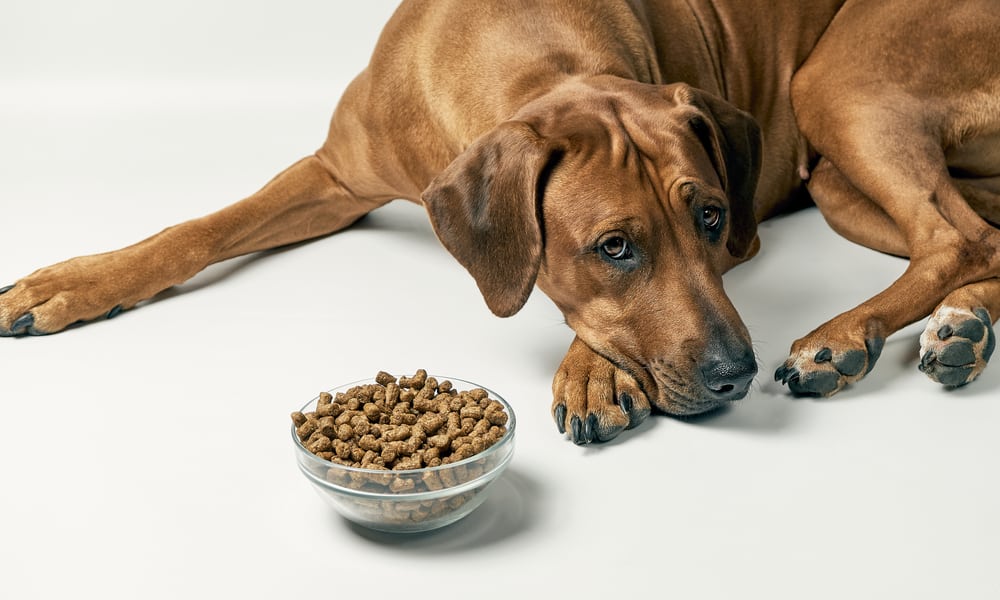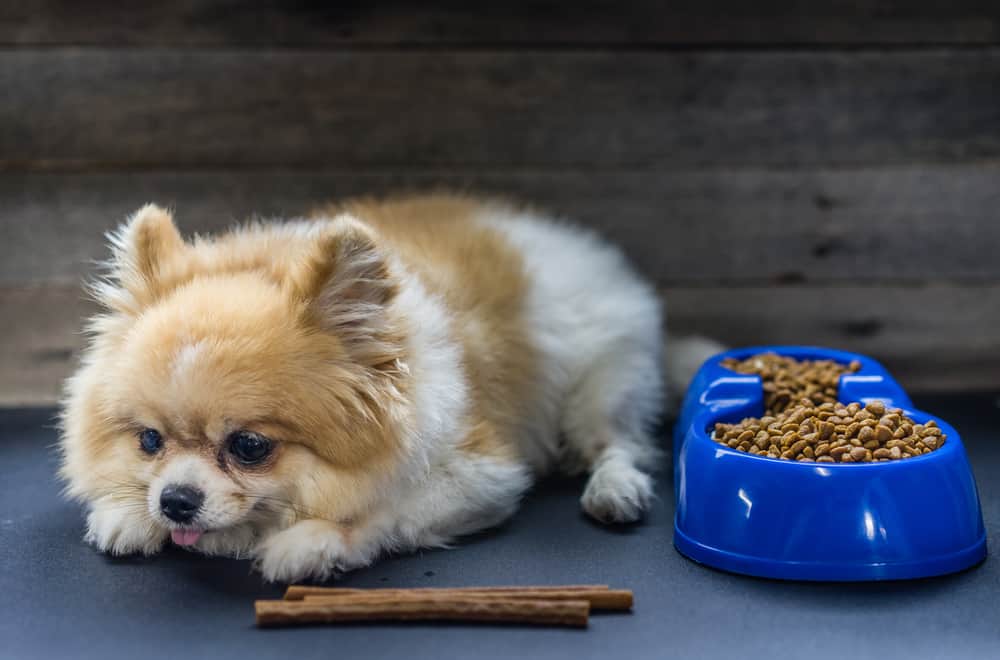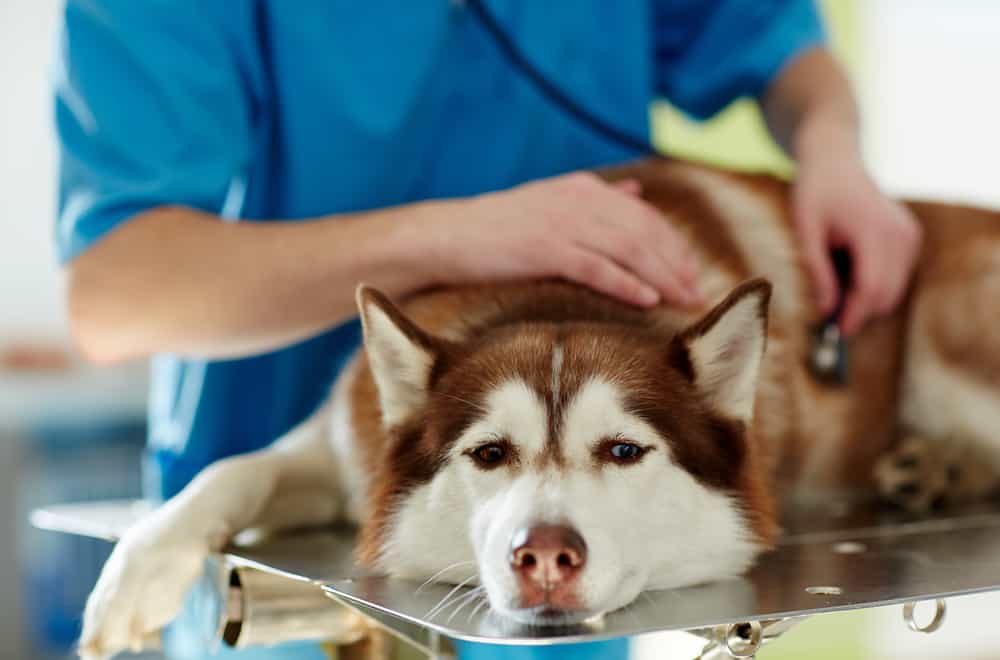Are you worried about your canine buddy’s loss of appetite? When your once good eater doesn’t even look at the bowl of food you’ve served, it can cause concern.
There are many reasons why dogs won’t eat. Don’t wait around for your pup to eventually feel hungry and come looking for food. As soon as you notice a change in eating habits, you should bring your dog to the vet to check for possible dog anorexia.
In this article, you will learn:
- What is dog anorexia
- The common causes of loss of appetite in dogs
- When you should be worried about your dog not easting
- What do when your dog doesn’t eat
What is Dog Anorexia?
Anorexia is a disease characterized by a reduction in food consumption. There are two types of anorexia: True anorexia and pseudo anorexia, and your dog may suffer from either.
True anorexia occurs when a dog loses interest in eating, even when you offer his favorite snack. Many factors can cause true anorexia. Examples include:
- Stress
- Unfamiliar environment
- Organ infection
- Exposure to poison
- Immune system imbalance
- Pain
- Side effects of medication
- Nausea
- Extreme weather
Pseudo anorexia occurs when a dog wants to eat but cannot do it. Fido might show interest in food and even try to eat but then stop halfway and back off from his bowl.
This reduction in food consumption is typically due to observable reasons. Factors that can cause pseudo-anorexia are:
- Cancer or a tumor in the mouth, gums, or tongue
- Disease of the salivary gland
- Chronic pain that may prevent the dog from picking up or swallowing food
- Dental diseases such as periodontal disease, gingivitis, and temporomandibular joint pain
- Inflammation of the throat or mouth tissues
What Causes Loss of Appetite in Dogs?
A loss in appetite may or may not be serious, but you should definitely pay close attention to your pup. These are the most common reasons why Fido might refuse to eat:
1. Illness
Sickness is the biggest reason why dogs won’t eat. Just like us humans, when feeling unwell, eating is the last thing your dog will want to do.
The illness may range from mild virus infection to a small ulcer in the mouth to something more serious like a mouth tumor. Dental problems such as swollen gums or problems with the teeth can discourage your canine friend from eating.
Diseases such as diabetes, liver problem, cancer, kidney disease, respiratory problems, and even issues with the digestive system will quickly affect the dog’s appetite.
Your pup may refuse to eat yet seem normal. But, don’t assume everything is fine just because the dog is behaving normally.
Refusing to eat can result in fatal starvation and dehydration. Prepare to rush your dog to the vet if the eating behavior doesn’t resolve after a few hours.
2. Emotional Issues
Aside from illness, dogs sometimes refuse to eat because they are experiencing emotional turmoil for one reason or another. Anything that would make your canine uncomfortable will easily interfere with their eating habits.
For example, when the owner or someone close to the dog dies, the dog may refuse to eat for a couple of days, which can cause severe starvation.
If you suddenly start leaving your dog alone, for example, when you head to work, the pup may stop eating as an act of defiance or because they miss you.
For a dog that experiences bullying and aggression from other dogs or starts to suffer from physical abuse, their eating habits might change as well because their environment is unfriendly.
Sometimes, Fido might be needy and want you to feed him by hand. When you serve his favorite meal in his favorite bowl, instead of chowing it down, puppy just turns his nose upward and away!
If you have ruled out disease, try cuddling your pup to reassure him of your love and presence. You can also try feeding him by hand to see if he eats.
3. Foreign Object Ingestion
It is common for dogs to eat all kinds of strange objects, including toys, sticks, and even shoes. Objects your dog swallows can take up to 24 hours to move through the digestive tract.
Sometimes, objects become stuck in the digestive tract, resulting in foreign body obstruction, a potentially life-threatening condition.
In addition to feeling a lot of pain, your pup may no longer want to eat due to the blockage. The condition may quickly deteriorate into vomiting, diarrhea, aggression, constipation, and lethargy.
If you suspect your doggy has swallowed a foreign object, bring him to the veterinary clinic immediately. Blockages will not only result in a reduction of food consumption; they can also cut blood supplies to the digestive tract, which can result in the death of your beloved pet.
4. Changes in the Smell or Taste of Food
Dogs will notice even the slightest changes to their environment, including the food you serve them. Like humans, canines prefer to stick to the familiar and may turn their noses away from food that smells or tastes different.
For starters, check that the food you are feeding your dog is fresh. Don’t expect Fido to eat rotten food!
If possible, don’t make massive changes to the dog’s food all at once. Instead, introduce new foods slowly. For example, if tuna is your pup’s favorite, he might take a while to adjust to a meal with chicken strips. You could try pouring some chicken broth on top of the usual tuna dish to introduce doggy to the taste of chicken.
Watch out for so-called “new and improved” foods. If you see such a label on your dog’s usual food packaging, it means the food content has changed. The chances are good that your dog may refuse to eat the food.
When Should You Be Worried About Your Dog Not Eating?
Let’s face it when your dog won’t eat, there’s a problem. Dogs don’t just stop eating for no reason.
You might think you know your dog well to tell when he has a problem. But, unless you are a qualified veterinarian, you cannot really know if your dog is suffering from an underlying condition and the seriousness (or not) of this condition.
This is why I strongly recommend bringing your pup to the veterinarian sooner rather than later. Fido might seem well for the first few hours of not eating, but I can assure you that his condition will quickly deteriorate unless he resumes eating as usual.
If doggy is not showing any signs of distress, you can wait 6 to 12 hours to see if he resumes eating. Observe the dog closely at all times for any alarming physical or behavioral changes.
A rule of thumb is to bring your dog to the veterinary if the loss of appetite is accompanied by vomiting, diarrhea, coughing, or lethargy. These are clear symptoms that your dear pet is unwell and needs immediate medical attention.
If your dog seems constipated and writhing in pain, it has probably swallowed a foreign object and will therefore refuse to eat. Any signs of pain should be taken seriously and brought to your vet’s immediate attention.
What Can You Do When Your Dog Doesn’t Want To Eat?
When your dog won’t eat, there are a few things you can do to bring back his appetite. But, first, your veterinarian needs to diagnose your pet to determine the best treatment.
If your vest suspects a serious underlying issue, she will recommend the required tests to determine what ails Fido.
That said, the first response will be to treat the symptoms related to dog anorexia. For example, if the dog is in pain, Non-Steroidal Anti-Inflammatory Drugs (NSAIDs) may be administered.
Your veterinarian may also prescribe some appetite stimulants or supplements to restore mineral imbalances, which can cause loss of appetite.
If your dog has lost a lot of weight or is dehydrated, it may be necessary to insert feeding tubes through the nostril to the stomach. This will help deliver much-needed food, supplements, and medicine without bothering the dog any more than necessary.
Aside from these emergency measures, you can also take some practical steps to boost your pup’s appetite when you get home:
- If you have been feeding your dog dry food, try canned food; Fido might like the new wet texture
- Add a bit of warm water to soften your dog’s food
- Warm the food to about 34 to 36 degrees Celsius
- Enhance the kibble’s flavor by adding low-salt beef, chicken, turkey, or beef broth
- Cook your own dog meals following recipes your veterinarian recommends
- Make feeding comfortable for your dog. Try serving meals in bowls of different heights to find out your dog’s preference
- Playing with or exercising your dog before mealtime can put him in a good mood and also make him hungry
- Cut back on treats before mealtime
Summary: Why Dogs Won’t Eat
It is not normal for a dog to refuse to eat. If this happens, there is a problem, especially if your dog has always been a good eater.
Some dogs are picky eaters, but a sudden loss in appetite should be taken seriously and brought to the attention of your veterinarian.
With your vet’s guidance, you can identify suitable treatments and home remedies for a dog that won’t eat.


